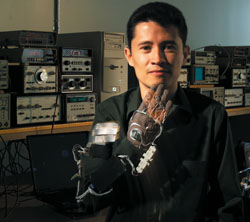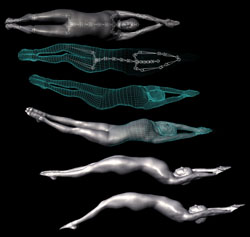Getting Out of the Ivory Tower
Technology transfer helps bring University inventions
to market.

|

Jose Hernandez-Rebollar and the AcceleGlove, which uses sensors, accelerometers,
and algorithms to translate the hand motions of American Sign Language
or other hand- and gesture-based languages into oral or written language.
Doug Benton/Fisheye Photography
|
Jose Hernandez-Rebollar, DSci ’05, graduate of
the doctoral program in computer engineering and now
visiting assistant professor of engineering, is fielding
calls from rehabilitation centers and investors interested
in his AcceleGlove. The device uses sensors, accelerometers,
and algorithms to translate the hand motions of American
Sign Language or other hand- and gesture-based languages
into oral or written language. It should prove useful
in hospitals and other settings in which understanding
speakers of ASL is necessary, as well as in ASL training.
The March 2005 issue of Reader’s Digest pegs it
as one of 10 “inventions that will rock your world.”
Akbar Montaser, professor of chemistry, recently met
with a company from France and another from Nebraska
about his innovative designs of the nebulizer devices
that spray samples of material into the hot plasma used
in inductively coupled plasma mass spectroscopy, a major
tool in the analysis of the chemical composition of samples.
Montaser already has a patent on his DIHEN design and
has received royalties from a license agreement for that
invention with a glass nebulizer manufacturing company.
These royalties have been devoted to new research on
nebulization at GW. His more recent advances involve
the development of “smart” nebulizers that
monitor and control the quality of the aerosol spray
for potential applications in a variety of areas, including
chemical analysis, pharmacology, and the automobile industry.
Rajat Mittal, associate professor of engineering and
applied science and specialist in fluid dynamics, has
developed a new design for the fins on autonomous underwater
vehicles used in military applications that allow them
to move more efficiently and stay at work longer. Mittal’s
expertise in motion through water also was sought after
by the U.S. Olympic swim teams.
Jason Zara, assistant professor of engineering and applied
science, has been talking to companies about his scanning
mirror design, which promises to improve medical imaging
to the point that biopsies may no longer be required
in order to diagnose certain cancers. Because it is small
in size but permits large scanning angles, the amplified
piezoelectric bimorph scanning mirror has the potential
to improve detection of tumors close to the surface in
places such as the eye, skin, and bladder.
These and other GW professors are benefiting from an
experiment aimed at pushing the University forward in
the area of technology transfer. Associate Vice President
for Graduate Studies and Academic Affairs Carol Sigelman,
in collaboration with Associate General Counsel Linda
Schutjer, contracted in January 2004 with a trio of consultants
from Deloitte and Touche to introduce a new approach
to technology transfer that is being tested on the nonmedical
side of the University. The Deloitte team, which has
since gone independent as TreMonti Consulting, brings
to GW expertise in evaluating, marketing, and licensing
new technologies.
The TreMonti team began by reaching out into science
and engineering departments to introduce themselves to
the faculty, identify promising research discoveries,
help inventors disclose them properly to the University,
and provide GW with a preliminary evaluation of them.
Sigelman formed an intellectual property review committee
to discuss emerging technologies on a monthly basis and
recommend what should be done with them. The first members
included Sigelman and Schutjer, engineering professor
Charles Garris, research engineering professor David
Nagel, management science associate professor Elias G.
Carayannis, and Diana Lipscomb, the associate dean for
faculty and research of the Columbian College of Arts
and Sciences. In addition, GW alumni with relevant experience,
among them Alan Nadel, BS ’71, JD ’76, a
partner with the law firm Akin Gump, and Rishi Nangia,
BA ’97, BS ’97, of Winston & Strawn,
have generously donated their time to the cause, as have
volunteers Todd Juneau of Juneau Partners and Richard
Spivack of NIST.
When the review process suggests that an invention is
likely to have commercial potential, the TreMonti team
markets it to appropriate companies and shepherds it
toward either a licensing agreement or a sponsored research
agreement to allow its further development at GW. Inventions
are also listed at GW’s New Technologies web site,
www.gwu.edu/~research/gwnt, which already is attracting
inquiries.
The result in only a year’s time has been a surge
of invention disclosures, patent filings, and interactions
with companies—and a good deal of buzz about technology
transfer.
The AcceleGlove was one technology incorporated this
spring into the business school’s New Ventures
Initiation course, taught by Carayannis. A student team
in the course developed a business plan laying out how
to commercialize the AcceleGlove. Another team developed
a plan for a blood pressure monitoring device, which
was a product presented to them by students in an engineering
design course taught by Hernandez-Rebollar. Both teams
assessed whether startup companies could be built around
the two products. The students presented their business
plans to two panels of venture capitalists, angel investors,
and other expert service providers and received valuable
guidance as well as an expression of interest and follow-up
by at least one risk capital firm.
Simon Berkovich, professor of engineering and applied
science, was invited to present his invention at an MIT
Enterprise Forum showcasing inventions developed at Washington
area universities. He was pleased to have TreMonti join
him in a meeting with SNAPP Technologies Corp., a company
now evaluating his computer routing system based on REBUS
architecture as a possible enhancement of its own technology,
designed to serve as a software development platform
and to enable high-speed grid computing. TreMonti representatives
were very instrumental in the negotiations, according
to Berkovich. “I could hardly understand 50 percent
of their discussion, but without their input it would
have been much more difficult to get to an agreement.”
Similarly, Zara notes that “it has been very nice
to have someone following up with the companies and handling
things like nondisclosure agreements. It frees me up
to just talk to people about the science.”
Meanwhile, TreMonti is helping Montaser negotiate a
license agreement with a French company for his new demountable
DIHEN, and Mittal is talking to a company that develops
autonomous vehicles.

Rajat Mittal, a specialist in fluid dynamics,
is using his expertise to assist the U.S. Olympic
swim teams by creating computer images of swimmers
in motion. His work has been written about extensively
in publications such as The Wall Street Journal
and The New Yorker. Mittal also has developed a
new design for the fins of autonomous underwater
vehicles used in military applications.
Chun-Ting Ma and James Hahn, Institute
for Computer Graphics
|

|
Many developments are occurring in the Medical Center
as well. Pat Berg of Biochemistry and Molecular Biology
has a patent on a gene she cloned, a gene that appears
to be activated in many types of cancer and might be
a key to preventing or treating cancer if it could be
shut down.
Steven Patierno, professor of pharmacology, genetics,
and urology, and executive director of the GW Cancer
institute, along with GW and former urology chair Michael
Manyak, holds 11 patents relating to his research. The
patents, licenced to a pharmaceutical company, involve
therapy and administration of an anticancer protein that
provides for new methods of prostate and lung cancer
diagnosis, treatment, and gene therapy. Having obtained
the first of these patents in 1995, “This is a
prime example of a patent portfolio developed at the
University that translates into commercial development,” he
says.
Alumni also are helping GW’s technology transfer
efforts. April 20 marked the first meeting of the Entrepreneurs
Roundtable, a group of faculty members and alumni with
interests in technology transfer. Spearheaded by Tejbir
Singh Phool, a member of the GW Alumni Association Board
of Directors, the roundtable’s aim is to mobilize
faculty members and alumni to foster entrepreneurship
among GW’s students and faculty. Concepts such
as a speaker series, events to showcase new inventions
to potential investors, and mechanisms for involving
faculty, alumni, and students in advising inventors on
how to commercialize their technologies are being discussed.
Representatives of the School of Engineering and Applied
Science and the School of Business are meeting in parallel
to discuss how to further develop and integrate their
course offerings in the entrepreneurship area and how
best to use the available expertise to incubate promising
inventions.
“Our technology transfer successes can only mount
from here,” Sigelman says. “There are many
exciting discoveries on both the medical and non-medical
sides of the University, and now that Anne Hirshfield
is in place as the associate vice president for health
research, compliance, and technology transfer, medical-side
technology transfer activity will only increase. The
goal is to provide the best support we can to GW inventors
and to see to it that the products of GW’s most
inventive minds get out of the ivory tower and into the
marketplace where they can do the world some good.”
|